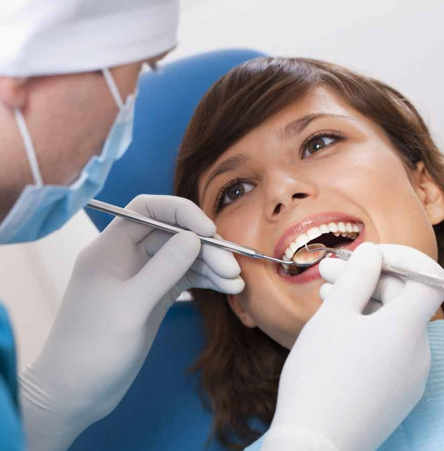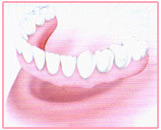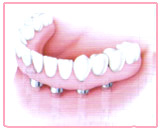


Removable full denture

Implant Supported Overdenture
Upper jaw is called MAXILLA. The available bone in the upper jaw for placement of implants is below the nose cavity and maxillary sinuses. When compared to the lower jaw, the upper jaw bone is very soft and more time is taken for the implants to get united to the bone. Placement of implants is more demanding in upper jaw as it is the upper teeth which are more visible during smiling. So the assessment of upper lip length and smile line is very important and that will decide on the placement of implants. There are two large sinuses called maxillary sinuses are in the upper jaw on the either side of the nose. In patients who lost upper teeth for long time the upper jaw shrinks to such extend the placement of implants is possible only with bone grafting /augmentations.
The part of the jaw bone holding the teeth starts shrinking and you will loose the shape of the face. Impairment of chewing and speaking causes social and health problems. The only treatment that can prevent shrinking of bone is to place implants. The jaw bone recognizes the implant as the lost root of the teeth. The function imparted by the implants increases the density of the bone and the shape is maintained. So dental implant is done not only for cosmetic reasons but also for functional reasons.Removable dentures aggravate the bone shrinking especially in the upper jaw.
The jaw bone shrinks to such an extent that the placement of implants will be difficult. Additional surgical procedures will be needed for bone augmentations and to place the implants.
On examination if the bone volume is less then bone augmentation procedures are needed to place the implants. This can be done safely by trained maxillofacial surgeons. So if you have been told that there is insufficient bone by any implant dentist, your next step will be to meet a maxillofacial surgeon trained in implant dentistry.
It is also noticed that some implant dentists who are not trained in placing implants in compromised jaw bone in the back of the mouth removes good front teeth to place implants so that the back teeth can be cantilevered from the front implants which is not a good practice.
Some of the surgical procedures to augment jaw bone that can be mentioned are as below.
Long periods of tooth less condition will lead to shrinking of jaw bone both in vertical and horizontal dimension. At scientific dental clinic Dr Kuldeep Singh routinely does ridge split technique using piezo electric bone surgery unit. This specialized machine work with piezoelectric mechanics. The knife edged thin bone is split and widened to accommodate the correct size of implants and interposition bone graft is used at the time of placing implants to fill the dead spaces.This is a highly successful surgical treatment Dr Kuldeep singh usually does this under local anesthesia .Careful handling of the bone is very important to maintain the blood supply of the bone and in turn the integration of implant
This also is done as two stage procedure where the ridge split is done with bone grafting as the first procedure. Once the bone is augmented to the desired width after a healing period of six months implants are placed. But in 99% of the cases Dr Thomas places implants at the time of ridge split and a second surgery is avoided. Those who are not trained to do this procedure usually discourage patients advising them that they have no bone and hence they are denied the opportunity of replacing lost back teeth with dental implant treatment thus compromising the quality of life.
Long periods of tooth less condition will lead to shrinking of jaw bone both in vertical and horizontal dimension. To increase the width and height of the jaw bone to accommodate a good sized implant a piece of bone (block of bone) is harvested from a site near to the implant placement site. The usual site for harvesting the block graft is from the chin, ramus of the mandible, ankle of the mandible etc. Dr Thomas does this procedure also under local anesthesia. The graft harvested is fixed on to the thin jaw bone where an implant cannot be placed otherwise. Fixation of the block graft is done by titanium osteosynthesis. Interposition graft is also used along with this. Since the donor and recipient sites are in same region patient discomfort is minimal.
The maxillary sinus if they are very big then the available bone under the sinus for the placement of implants will be minimal. A trained surgeon can safely access the sinus directly from the front wall of the sinus. A window is made in the front wall of the sinus without damaging the sinus membrane lining the sinus. Maintaining the integrity of this sinus membrane is the key to the success of the integration of the graft. This sinus membrane is lifted and bone graft is placed inside the sinus under the membrane which consolidates to form thick bone for the implants to be placed. This is also routinely done by Dr Thomas under local anesthesia.
If the implant can be secured achieving a primary stability then sinus grafting and placement of implants can be done at the same time. But if the residual bone under the sinus is too thin then sinus grafting alone is done as a first stage. After a healing period of six months implants are placed in the grafted bone as second procedure.
Usually a drill is used to make site for placement of implants. Under the sinus if the bone is very thin then using a drill most certainly damages the sinus membrane. Instead an instrument called osteotome is used safely to push the membrane up at the same time an implant site is created. Then bone grafting materials are placed under the sinus membrane thru the access made. Most often the implants are also placed simultaneously.
Using specialized surgical instruments the implant site is expanded or widened to accommodate implants. This also can be safely done under local anesthesia.
To replace all the teeth in the upper jaw 6 implants are needed. The placement of implants can be done in one surgery or a maximum in two days time. The time needed will be one hour each.In three days time a temporary denture will be fabricated and given.
Two to four implants can be used to stabiles the denture. With this treatment you still have to remove the denture. But this is cost effective treatment for stabilizing a very loose denture.
Single piece implants with ball heads can be inserted to the jawbone and dentures can be immediately loaded. This is very quick and less expensive treatment to stabilize the denture. Since the implants are loaded immediately the success rate of such implants are less than a two stage treatment. In two stage treatment you leave the implants submerged in the bone for Osseo - integration to happen. With this treatment the success rate is as good as any two stage process. The advantage of this treatment is that at a later stage more implants are placed then this can be converted to complete non removable implant supported prosthesis.
In the upper jaw dental implant treatment is very successful. 96% -98% successes is easily achieved. The healing period between the first and second stage is 4 to 6 months and implants loading time is more compared to the lower jaw.
The artificial teeth can be metal fused porcelain crowns which can be cemented on to the abutments or screw retained. In case of severely shrunken jaw and when the patient has facial changes hybrid dentures are the choice. This has the features of dentures and crowns.In some cases dentures can be stabilized by implants as over dentures or bar retained dentures.
In normal maxilla implants can be loaded in four to six months time. When surgical techniques are used to augment the jaw bone by bone grafts etc more healing period is required and up to six to 8 months are needed.
When complete replacement of upper teeth is done with dental implants, there is difficulty in stabilizing temporary denture. There are no existing teeth to which the denture can take support by way of clips or other accessories. The temporary denture can also exert pressure to the implants impairing the union of implants to the bone.
To help the situation transitional implants are used to support the temporary denture. These are very slender implants which are single piece unlike the conventional implants which are totally buried in the bone under the gum. The TRI will protrude thru the gum and has a ball head. The fitting surface of the denture will have nylon ring to snap fit into the transitional implant ball head. This mechanics give stability for the upper temporary denture.
The life of transitional implants is less than conventional implants are they are immediately loaded. By any chance if the TRI also get integrated then it will also be incorporated into the permanent teeth.Two TRI are needed in each jaw making four TRI for the full mouth.
If you are missing a tooth and if you are advised to grind the adjacent good teeth to place a dental bridge consider implant. Ask your dentist why implants are not recommended instead of grinding down good teeth. Remember the life of an average tooth supported bridge is anywhere from 10 to 11 years. You will loose more teeth and ultimately more implants are needed. Then why not consider implants in the first instance.Each tooth is an organ of your body and don’t allow anybody to damage it. Remember you have the right to choose what is best for your health.Implant treatment is 98% successful. An integrated implant is 8 times stronger than natural tooth and can last a life time.